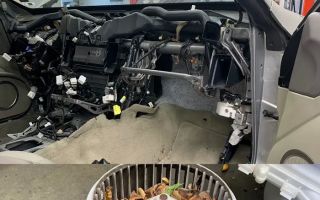What to Do If Your Car is Stuck in a Ditch: A Step-by-Step Guide
Finding yourself with a car stuck in a ditch can be a frustrating and stressful situation. Whether it’s a result of heavy rain, a slick patch of ice, or an unintentional steering mistake, the first few moments after realizing your car is stuck can leave you feeling helpless. But don’t panic! There are steps you can take to safely and effectively resolve the situation without causing damage to your vehicle or injuring yourself.
In this article, we will provide you with a comprehensive guide on what to do if your car is stuck in a ditch. From safety precautions to potential DIY solutions, we’ve got you covered. Whether you're on a rural road or caught in a muddy patch, knowing how to handle this situation can save you time, money, and a lot of frustration. Keep reading for practical advice, expert tips, and steps that will help you safely get your car back on track.

Pick Your Part - Help Yourself
1232 Blinn Ave, Wilmington, CA 90744, USA
1. Assess the Situation: Ensure Safety First
The first and most important step when you find yourself in a ditch is to assess the situation carefully. Is your car on a busy road or in a remote location? Are there any oncoming vehicles? Your safety should always be the top priority. Follow these initial steps:
- Stay Calm: Panic can cloud your judgment and lead to rash decisions. Take a deep breath and focus on the next steps.
- Turn on Your Hazard Lights: Flashing lights will alert other drivers to your situation, reducing the risk of further accidents.
- Check Your Surroundings: Before exiting the vehicle, make sure the road is clear, and it is safe to leave your car. Look for nearby traffic, oncoming vehicles, or any other hazards that could pose a risk.
- Inspect the Ditch: Check the depth of the ditch and the surrounding area for any obstacles like rocks, roots, or sharp edges that could damage your vehicle or make the situation worse.
2. Check for Vehicle Damage
Before attempting to free your vehicle, you need to ensure that it hasn’t sustained any significant damage. Look for signs of body damage, such as dented panels, broken headlights, or anything that could indicate serious impact. If the car is heavily damaged, it’s better to call for professional help rather than risk further harm to your vehicle by trying to drive it out of the ditch.
If the vehicle seems to be in good condition and there are no obvious signs of damage, you can move to the next step. It’s important not to attempt anything that might cause further harm, especially to critical components like the transmission or suspension.

Pick Your Part - Greer
13054 E Wade Hampton Blvd, Greer, SC 29651, USA
3. Try the Gentle Rocking Technique
One of the first methods you should try is the gentle rocking technique. This method can help free your vehicle from a shallow ditch, especially if your tires are just stuck in mud, snow, or sand. Here's how you can do it:
- Shift to Low Gear: For manual transmissions, shift the car into low gear. For automatic transmissions, use the lowest gear setting available (usually "L" or "1").
- Rock the Car Back and Forth: Gently accelerate forward and then immediately reverse. Do this repeatedly, rocking your car back and forth. The motion can help the tires gain traction.
- Avoid High-Speed Movements: Don’t attempt to gun the engine or spin the tires excessively. This can cause more damage, especially to the drivetrain or the tires.
- Steer Carefully: While rocking, steer the wheel slightly to the left and right to help the tires move in the direction they need to go.
Be patient and give yourself time. If this method doesn’t work, don’t force it. Move on to the next strategy.
4. Use Traction Aids
If the rocking technique doesn’t help, using traction aids could be the next best option. Traction aids like sand, gravel, or a traction mat can provide the additional grip your tires need to get out of the ditch. Here's how to use them:
- Sand or Gravel: If you're near a sandy or gravelly area, use these materials to create a surface under your tires. Gently sprinkle sand or gravel in front of the tires, allowing them to grip the surface better.
- Traction Mats: If you have a traction mat (also called a recovery mat), place it under the tires to help create traction. These mats are designed to grip and provide enough friction to help get your vehicle out of tough spots.
- Carpet or Floor Mats: If you don’t have traction mats, try using your car’s floor mats. Lay them under the tires to increase grip and give your vehicle some traction to move forward.
Once you've placed the traction aids in place, repeat the rocking technique slowly to help your car free itself from the ditch. Be cautious when using traction aids, as they can cause damage if improperly used or applied too aggressively.
5. When to Call for Professional Help
Sometimes, the situation may be more complicated than it seems, and trying to free the vehicle yourself could cause more harm than good. In these cases, it's best to call for professional help. If any of the following apply to your situation, it’s time to contact a towing service:
- Severe Damage: If you notice significant damage to your car, such as a damaged undercarriage or a broken suspension, calling a professional is necessary.
- Deep Ditch: If your car is deep in a ditch or if the terrain around the ditch is uneven or muddy, professional tow trucks have the equipment needed to lift and safely remove the vehicle.
- Unsafe Conditions: If it’s not safe to stay in or around your car (e.g., due to oncoming traffic, icy conditions, or potential flooding), immediately call for roadside assistance.
6. Preventing Future Incidents
While getting stuck in a ditch can happen to anyone, there are steps you can take to prevent it in the future. Here are some preventive tips:
- Be Mindful of Weather Conditions: Avoid driving in heavy rain, snow, or icy conditions when possible. These conditions can make roads slippery and increase the likelihood of getting stuck.
- Avoid Off-Roading: Unless you're driving an off-road vehicle, avoid paths that could lead to ditches or other hazards. Stick to paved and maintained roads.
- Drive Cautiously: Always be aware of the road conditions and adjust your driving accordingly. Slow down in unfamiliar areas to reduce the risk of sliding off the road.
Taking preventive steps can help you avoid getting stuck in the future, but if you do find yourself in a ditch, remember that staying calm, assessing the situation, and using the right techniques can get you out safely.
Conclusion: How to Handle a Car Stuck in a Ditch
In conclusion, if your car is stuck in a ditch, don't panic. By following the steps outlined in this guide, you can increase your chances of safely getting your vehicle out. From assessing the situation and ensuring your safety to trying the rocking technique and using traction aids, there are several ways you can free your car without causing further damage. And if all else fails, remember that professional help is always a phone call away. For those who find themselves in frequent roadside troubles, services like [Rescue & Towing] are available to provide immediate assistance and help you get back on the road quickly and safely.
SEO Title: What to Do If Your Car is Stuck in a Ditch: A Step-by-Step Guide SEO Keywords: car stuck in a ditch, how to get out of a ditch, car ditch recovery, professional towing services, driving in a ditch SEO Description: Learn how to safely get your car out of a ditch with these expert tips. From the rocking technique to using traction aids, get your vehicle back on track and avoid damage.


























